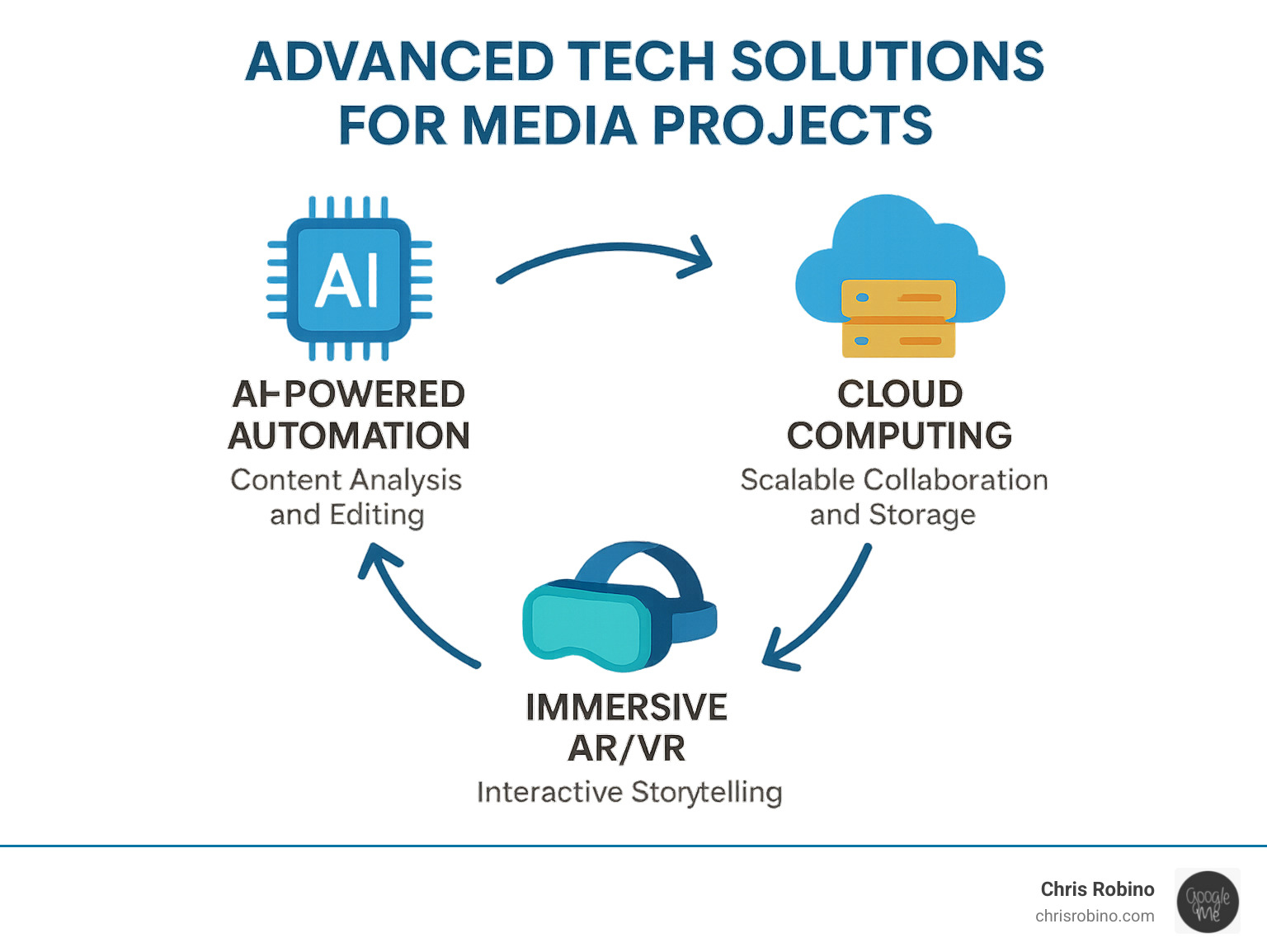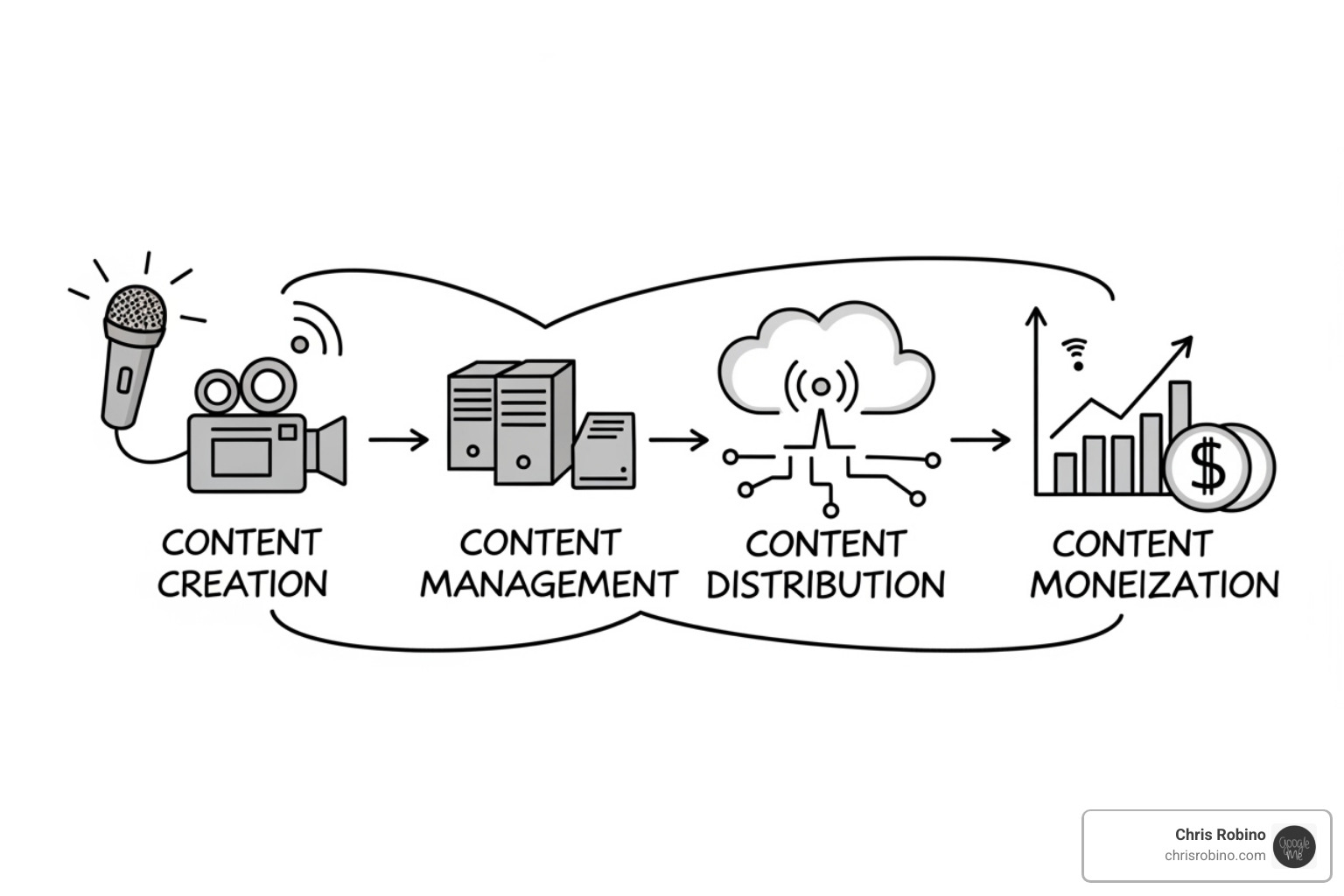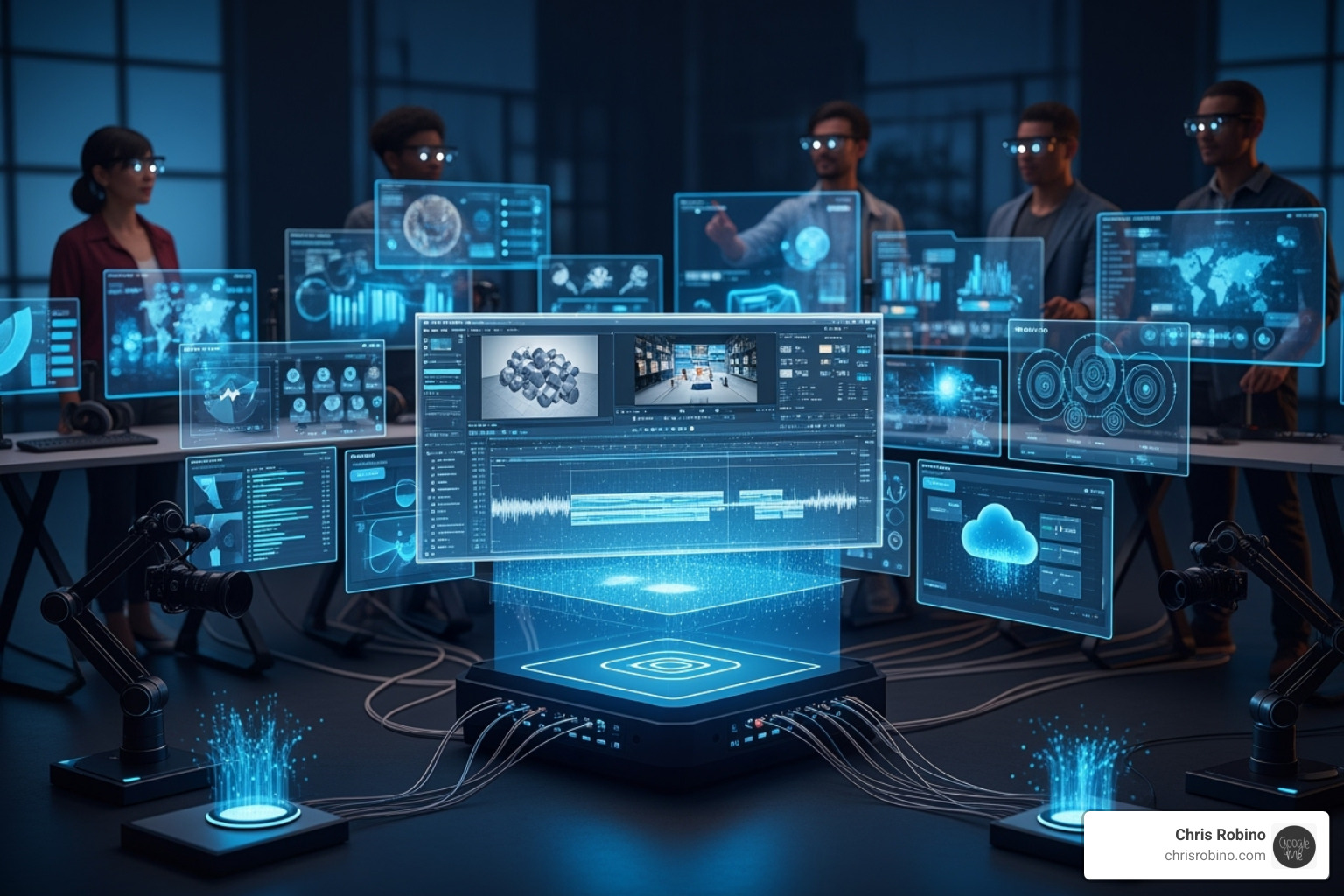Why Advanced Tech Solutions Are Changing Media Production
Advanced tech solutions for media projects are revolutionizing media production in 2024. The landscape has shifted from traditional workflows to intelligent, cloud-powered systems that scale instantly and deliver faster results.
Top Advanced Tech Solutions for Media Projects:
- AI-Powered Tools: Automated video editing, speech-to-text transcription, content analysis, and personalized recommendations
- Cloud Infrastructure: Scalable storage, real-time collaboration, Content Delivery Networks (CDN), and remote production capabilities
- Immersive Technologies: AR/VR integration, virtual production sets, 360-degree video, and metaverse development
- Intelligent Asset Management: AI-driven search, automated metadata tagging, and smart content organization
- Live Streaming Solutions: Sub-second latency, unlimited parallel streams, and real-time clipping tools
The numbers tell the story. Companies using advanced media tech report 99.95% uptime guarantees and can process hundreds of live streams simultaneously. AI tools now transcribe speech in 27 languages while automatically detecting objects and generating highlights from video content.
These tools solve real problems media professionals face, from managing massive video libraries and collaborating across time zones to creating personalized content at scale.
As Gabriel Millet noted about the Cannes Festival coverage: “We achieved more than 200 million views of Cannes Festival-related content, and an advanced media platform was key in enabling us to work together on rushes and publish to our platforms extremely quickly.”
The shift is clear. Traditional, manual workflows can’t compete with integrated platforms combining AI, cloud scalability, and immersive experiences.
I’m Chris Robino, a Digital Strategy Leader and AI & Search Expert with over two decades of experience helping organizations implement advanced tech solutions for media projects that drive measurable growth. Throughout my career, I’ve guided everyone from tech startups to established enterprises through digital change, focusing on AI-driven systems that lift performance and streamline complex workflows.

The Core Technologies Driving Modern Media and Why They’re Essential

The media landscape has transformed. Audiences now expect instant, personalized, and immersive content that traditional workflows can’t deliver. This isn’t just about keeping up; advanced tech solutions for media projects have become the foundation for survival and growth. The difference between success and failure often comes down to three core technologies: artificial intelligence, cloud computing, and immersive experiences.
These technologies create unprecedented scalability, enable data-driven monetization, and provide a crucial competitive advantage. With ubiquitous connectivity linking global audiences 24/7, the pressure to innovate is immense. The question isn’t whether to adopt these technologies, but how quickly you can implement them. This evolution in media innovation continues to reshape industries, as explored in our analysis of Innovation in Media Companies.
Artificial Intelligence (AI) and Machine Learning
AI now handles tedious tasks, freeing creative professionals to focus on their core work. Automated content analysis processes massive video libraries in minutes. AI analyzes every frame—identifying objects, people, and text—changing archived content into searchable, valuable assets.
AI-driven video editing tools allow editors to work at unprecedented speeds. Some platforms generate video from prompts, while others allow editing as easily as a document, with AI suggesting cuts and scripts. The impact on personalization is remarkable. Personalized recommendations analyze viewer behavior to suggest engaging content, while metadata tagging happens automatically, ensuring proper organization.
Speech-to-text transcription now works across 27 languages, making content globally accessible. Object recognition identifies everything from brand logos to locations, creating rich, findable metadata.
Generative AI pushes these capabilities further, creating new content from text prompts or animating static images. Leading news organizations have pioneered many of these applications, using AI in news gathering, production, and distribution. Industry initiatives for local newsrooms show how smaller organizations can leverage these powerful tools.
Cloud Computing: The Backbone of Modern Workflows
Cloud computing is the backbone of modern media, providing scalable infrastructure to handle massive data loads without large hardware investments. Cloud-based collaboration has revolutionized teamwork. Editors in different time zones can work on the same project simultaneously, a capability now essential for competitive media organizations.
Digital Asset Management (DAM) systems in the cloud ensure every file is securely stored and instantly searchable, with enterprise-grade security features. Content Delivery Networks (CDN) deliver high-quality streams with sub-second latency and 99.95% uptime guarantees, enabling interactive live events without frustrating delays.
Remote production capabilities mean teams can create professional content from anywhere, with distributed teams producing live events and post-production workflows spanning multiple locations. This shift is fundamental, as detailed in our explorations of Cloud-Based Computing and Moving from Ops System to Browser-Based to the Clouds.
Immersive Experiences: AR, VR, and the Metaverse
The future of media is immersive, with Augmented Reality (AR) and Virtual Reality (VR) creating new forms of content and engagement. Augmented Reality overlays digital information onto the real world. AR overlays real-time stats in sports broadcasts and visualizes complex data in news programs.
Virtual Reality transports audiences into digital environments for interactive storytelling. 360-degree video creates immersive documentaries and virtual concerts, making viewers feel present at events.
Virtual production uses game engines to build elaborate digital sets that can be modified instantly. This technology reduces costs and provides greater creative control. Metaverse development is the next evolution, with companies exploring persistent virtual worlds for new forms of interaction.
Immersive journalism uses these technologies to place audiences directly into news stories, creating deeper empathy and understanding. These developments are reshaping audience expectations and creating new revenue opportunities, as explored in our look at Media Industry Trends 2024.
How Advanced Tech is Revolutionizing the Media Lifecycle

Advanced tech solutions for media projects are reshaping the entire content lifecycle. This fundamental shift toward workflow automation boosts production efficiency, delivers deeper audience analytics, and drives substantial revenue growth. These technologies work as interconnected systems, making the media lifecycle smarter and more responsive.
Enhancing Content Creation and Production
Content creation is no longer defined by long hours and painstaking manual processes. AI-assisted editing tools can automatically identify compelling moments in footage, generate rough cuts, and create highlight reels. Advanced AI technologies can scan footage to pinpoint resonant moments, saving time and augmenting human creativity with intelligent insights.
Virtual sets and virtual production have revolutionized the use of physical space. Creators can design elaborate digital environments with game engines and interact with them in real-time on LED walls. The rise of prompt-based content generation is also exciting. Certain prompt-based tools and platforms can generate high-quality video at scale from simple inputs, automating everything from analysis to asset sourcing.
Modern text-based video editing lets you edit video by editing a transcript. It’s intuitive and fast, opening up video editing to more people. Real-time collaboration tools are now essential, allowing scattered teams to work on the same project simultaneously.
Streamlining Content Management and Distribution
Managing and distributing content is simplified by AI-powered Digital Asset Management (DAM) systems. These platforms understand, index, and make content instantly searchable across vast libraries. Intelligent video search goes beyond keywords, understanding context, faces, objects, and even emotional tone to deliver precise results in seconds.
Automated metadata generation eliminates a tedious task by having AI systems automatically tag content with relevant information. For distribution, optimized CDN delivery ensures content reaches global audiences with minimal latency, handling massive traffic spikes seamlessly.
Multi-platform formatting tools automatically adapt content for different social media platforms. Content performance analysis provides insights into audience interaction, helping media companies optimize future productions for maximum engagement and findability.
Opening New Monetization and Engagement Models
These advanced tech solutions are also creating new monetization and engagement models, moving beyond traditional ads and subscriptions to more dynamic, personalized approaches. Programmatic advertising uses AI to automate and target ad buying. Dynamic paywalls can adjust access based on user behavior.
Audience segmentation powered by real-time analytics allows for a granular understanding of viewers. This goes beyond demographics to understand behavior patterns and content preferences that inform both content and monetization strategies.
Direct-to-fandom commerce is a key development. Certain platforms enable creators to bypass traditional gatekeepers, protecting and monetizing their IP directly. This shift puts power back in the hands of creators, allowing them to build direct relationships with their audiences and control their revenue, a model that values quality content and authentic engagement.
A Look at Advanced Tech Solutions for Media Projects in Action

Advanced tech solutions for media projects are already changing how we create, distribute, and experience content. Here are some real-world examples of these powerful tools in action.
Live streaming has evolved far beyond simple broadcasting. Modern live streaming platforms handle massive events with high reliability, offering real-time encoding and adaptive bitrate streaming that adjusts to each viewer’s connection for a high-quality, low-latency experience.
During live events like major sports broadcasts, AI systems process hundreds of camera feeds to identify key moments and generate highlight reels in real-time. Advanced live asset management platforms can capture and record hundreds of streams while AI indexes content and creates clips, delivering highlights to social media minutes after they occur.
News production has seen dramatic change. Major news organizations use AI to improve their entire news operations, from identifying trends to assisting with content creation. This frees journalists from repetitive tasks to focus on telling important stories.
Digital advertising has been revolutionized by programmatic technologies that use AI to optimize ad placements in real-time, ensuring ads reach the right people at the right moment.
The gaming industry pushes boundaries with immersive experiences that blend reality and digital worlds, including interactive storytelling and live events improved with AR overlays.
Metaverse platforms represent the convergence of these technologies, enabling virtual concerts, interactive brand experiences, and collaborative workspaces that are no longer science fiction.
These applications solve real problems while creating new possibilities. A news team can collaborate across continents, a broadcaster can deliver personalized content to millions, and a small creator can achieve production values that once required a major studio. These examples show that advanced tech solutions for media projects are fundamentally changing what’s possible in media.
Navigating Implementation: Challenges and Best Practices
Implementing advanced tech solutions for media projects has undeniable benefits, but the path isn’t always smooth. Common challenges include integrating with legacy systems, ensuring data security, managing initial costs, and bridging team skill gaps. For clarity on technical decisions, our collection of Reasonable Tech Questions, Answers, How and Why can help.
Common Problems in Adopting advanced tech solutions for media projects
The biggest headache is often technical debt. Many media companies run on legacy systems not built for today’s cloud-based, AI-driven world, making integration difficult. Workflow disruption is another inevitable side effect when changing how people do their jobs, often meeting resistance from those comfortable with existing software.
Navigating the compliance maze of Digital Rights Management (DRM) and GDPR regulations is critical. Media content involves sensitive IP and personal data, so any new solution must meet strict legal and ethical standards.
The high initial costs can be overwhelming, even if the long-term ROI is substantial. Furthermore, measuring ROI on these complex solutions is not straightforward and requires sophisticated analytics and clear business objectives.
Finally, there’s simple resistance to change. Convincing a team that a new system will improve their work requires patience, training, and a clear demonstration of value.
Strategies for Successful Implementation of advanced tech solutions for media projects
Experience shows a phased migration approach is more effective than a complete overhaul. Starting with an MVP (Minimum Viable Product) is a wise strategy. Test a core set of features thoroughly to spot problems early and demonstrate value quickly, which helps maintain stakeholder support.
Don’t try to do everything in-house. Partner with domain experts who bring deep industry knowledge and can help you avoid costly mistakes. They understand media workflows and can guide you to the right tech stack.
Security isn’t optional; it’s foundational. This means robust content protection, tight access controls, and comprehensive data privacy measures to protect your most valuable assets.
Team training is where many implementations succeed or fail. Even the best technology is useless if your team can’t use it. Invest in comprehensive training and support to ensure your team can open up the platform’s full potential.
Finally, adopt an agile development process. The media landscape changes rapidly, so your technology must be flexible. This iterative approach allows for continuous improvement and quick pivots as market demands shift. Implementing these solutions is about changing how your organization works, and with the right strategy, you can steer the challenges successfully.
The Future of Media Tech: What’s Next on the Horizon?
The media industry is constantly evolving, with exciting developments on the horizon that could reshape how we create, share, and experience content.
Hyper-personalization is becoming more sophisticated than simple recommendations. Imagine a news feed that not only knows your interests but also your preferences for format and timing, adjusting content based on deep contextual understanding powered by AI.
The generative AI evolution is particularly fascinating. We’re already seeing AI write articles and edit videos, but we’re heading toward a future where it plays a larger creative role. Soon, AI could co-write documentaries, compose soundtracks, or design adaptive virtual sets, amplifying—not replacing—human creativity.
As AI becomes more capable, ethical AI frameworks are essential. The industry needs clear guidelines on disclosure, authenticity, and fair use to protect creators and audiences while fostering innovation.
Web3 and decentralization represent a shift toward creator control. Blockchain technology could allow creators to own their work more directly, receive immediate payment, and build stronger fan relationships, essentially cutting out the middleman. This aligns with emerging direct-to-fandom commerce models.
The real-time analytics convergence will provide instant feedback on content performance. This allows for live adjustments, such as tweaking a live stream based on audience engagement data or modifying a marketing campaign mid-flight.
Looking further ahead, quantum computing potential is an intriguing wild card. While still years from practical use, it could eventually handle complex simulations, create ultra-realistic virtual environments, and provide unbreakable security.
These advances in advanced tech solutions for media projects are about creating more meaningful connections, making content production more accessible, and opening up new forms of storytelling. The future of media tech is being written now, and for deeper insights, our Tech Industry Report offers valuable analysis.
Conclusion
The shift to advanced tech solutions for media projects is about reimagining how we create, manage, and share content. These technologies are redefining media by enabling intelligent, scalable, and immersive experiences.
The benefits are remarkable. Efficiency skyrockets as AI handles tedious tasks. Scalability becomes effortless with cloud infrastructure. Engagement deepens through personalization and immersive experiences. And exciting new revenue streams open up through advanced monetization and direct-to-fan commerce.
Adaptation is no longer optional. Traditional media models are being challenged by audiences who expect seamless, personalized experiences. The companies thriving today are those embracing AI, cloud flexibility, and immersive storytelling to solve real problems like inconsistent streaming quality, high infrastructure costs, and complex technical setups.
The media landscape will continue its rapid evolution. Generative AI will reshape content creation, Web3 will empower creators, and hyper-personalization will make every experience feel custom-made. Organizations implementing these advanced tech solutions for media projects today will lead tomorrow’s media revolution.
Navigating this complex landscape requires strategic vision. The difference between a successful implementation and a costly mistake often comes down to having an experienced guide who understands both the technology and the unique challenges of media production.
To steer the complexities of modern media production and implement the right solutions for your goals, it’s crucial to have an expert guide. Explore how we can lift your next project.
